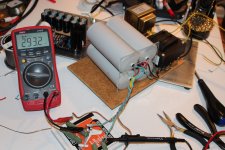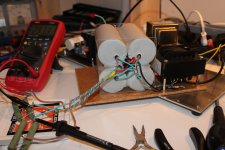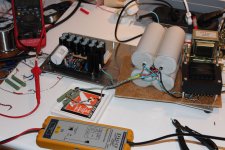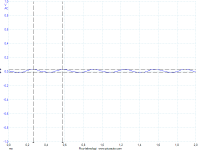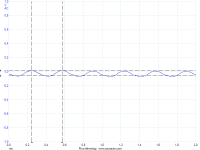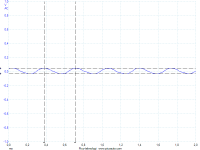I am to. Heres a shot: 499 mS peak to second lowm 85 mV P-P
I see about 0.32mS peak to peak cycle on that sine given the horizontal scale.
I am to.
Just use a single cap at the end of each resistor and return it to star?
Two shunts not working, bit odd.
Ya, but I soldered, mounted and tested them in parallell. Should I replace the IRFS?
Why dismantle DC stabilizing and normally trimming circuits? The IRFs don't they get hot and show Vgs? Have you tried using one reg on its own with that rectifier and filter practical scheme? Take one out, measure the remaining one again, is it the same mV? Personally I doubt there is something wrong in those circuits you built. On the other hand I don't know what that ~3KHZ wavy modulation is when using a grounded CMRR nullified differential probe, what ground inductance is there both in the power wiring and measurement loop wiring, what interference it can couple off air or what it can set off on two parallel fast CCS cascode inputs. Just too many question marks. One thing I know is its easy to get a flat line on a scope from SSHV2 when its CCS and shunt part are responding and nothing extraordinary happens elsewhere in the system.
Well. Since I passed out last night after soldering 3 different PSUs, wiggling with my unknown measuringtools and cutting my finger in a hunt for a few millivolt on a 300 V scale I woke up like Sponge Bob this morning wondering what now?
I dug up my antique tripple EL34 bench PSU and started to load with. Ofc enourmous ripple both in and out of SSHV. Started examining the boards. Wopsie, found a resistor R3 with wrong value. Changed that. No difference after tuning. Woopsie, found another one R12. Wtf was I drunk when I soldered them? Changed them. No difference. Then I looked at the documentation and found another schematic. Oh, just different versions of the same stuff (together with trimpots).
Uh. Maybe the DN2540s. They can be sensitive to s
tatic electricity and who knows. Changed all 4 to a new batch. No difference.
Took a walk, came home and built a 4th PSU. Its stands here now, smelling of hot loadresistors. Dual secondary 230 V CT, BYV26 sand rectifiers 50uF-10H-50uF-10H-100uF, all motors. Stable 293 out. Measures about like the others, a little better maybe.
With SSHV same out as in. But, as I look on the Pico with the diff probe, its not much of a difference between when probes are on the DUT or in the air. It just raises amplitude a little.
Measures are probes in the air, on input and on SSHV out.
I dug up my antique tripple EL34 bench PSU and started to load with. Ofc enourmous ripple both in and out of SSHV. Started examining the boards. Wopsie, found a resistor R3 with wrong value. Changed that. No difference after tuning. Woopsie, found another one R12. Wtf was I drunk when I soldered them? Changed them. No difference. Then I looked at the documentation and found another schematic. Oh, just different versions of the same stuff (together with trimpots).
Uh. Maybe the DN2540s. They can be sensitive to s
tatic electricity and who knows. Changed all 4 to a new batch. No difference.
Took a walk, came home and built a 4th PSU. Its stands here now, smelling of hot loadresistors. Dual secondary 230 V CT, BYV26 sand rectifiers 50uF-10H-50uF-10H-100uF, all motors. Stable 293 out. Measures about like the others, a little better maybe.
With SSHV same out as in. But, as I look on the Pico with the diff probe, its not much of a difference between when probes are on the DUT or in the air. It just raises amplitude a little.
Measures are probes in the air, on input and on SSHV out.
Attachments
I dug up my antique tripple EL34 bench PSU and started to load with. Ofc enourmous ripple
What did you do exactly with that PSU? Used it as a pre-reg? Did you try just a single regulator with its twin disconnected?
What did you do exactly with that PSU? Used it as a pre-reg? Did you try just a single regulator with its twin disconnected?
I fed one SSHV. Also tried with decoupling caps on input. No difference.
Put them on the pre and listen for bad clues or not. Changing the feed from your rectification(s) to a tube regulated PSU, from twin to single shunts, or probes just on air, and still picking the same 0.32mS period without serious difference looks like its EMI or an artifact.
Yes, well the only thing that is consistent over all the measurements is my apartment and the measuringtools. I would need something reliable to measure with and understand what I do. I almost went of to buy a Fluke True RMS DMM today but lucklily something came in the way.
Put them on the pre and listen for bad clues or not.
I will tomorrow. Desk jockeying starts in a few hrs. I would be surpriced if that ripple, or whatever it is is audiable. But another circuit intead of dummies can ofc give new surprices.
I dug hard today for a suitable common mode choke to see if it makes any difference, but I didnt find any with decent values.
Don't be psyched about it. When we get into the world of measuring tools and techniques there are a zillion things we may meet. True RMS DMMs I got 3 and I can tell you that their function is just to report correctly for amplitude on non sinusoidal AC. Even with those my FLUKE 87V did not know that the RMS of a PULSE (single ended square) has 0.707RMS the PK instead of 0.5RMS PK. But my DC+AC capable MASTECH knew as my scope also. Just a small example of what details may be lurking about. Few DMMs do up to 100kHZ in Volts sensitivity. In mV they lose breath.I almost went of to buy a Fluke True RMS DMM today but lucklily something came in the way.
When you pick same stuff with probes just dangling on air with what you pick on cables its tell tale its not circuit related.
I feel for you bro. I have been there. Irritating as hell.
You got a nice 465B I think I saw somewhere on a photo?
I dug hard today for a suitable common mode choke to see if it makes any difference, but I didnt find any with decent values.
My 2C is just don't throw more good money after bad on extra parts or random metering equipment. Find the people that know why they need a PC scope and a diff probe on EBAY, sell yours to them, get a classic cathode ray oscilloscope in good condition and maybe you end up with money to spare also.
My 2C is just don't throw more good money after bad on extra parts or random metering equipment. Find the people that know why they need a PC scope and a diff probe on EBAY, sell yours to them, get a classic cathode ray oscilloscope in good condition and maybe you end up with money to spare also.
Well, I started to interest in measuring now that you bossed me around on it a bit. Common mode chokes are good, with or without crappy measuring tools
But I think I have ruled out GND artifacts now, its the same results with yeallow/green GND in or out.
The thing that enoys me now is that my UNI-T (that say it shall measuere True RMS) follows the scope measurements anoyingly well but on some different scale. When I get 75 mV PP on Pico I get around the same RMS on the UNI-T
Just after you gave recommendation on scope yesterday I missed an auction on local fleabay on a 4 channel 100 MHZ Hameg that went for 76 euros.
Jinx. Make sure you confirm those offerings are fully working though.
You got a nice 465B I think I saw somewhere on a photo?
Yup. Need to invest in good probes, but otherwise works great. $100 on fleabay. Need to get a good sig gen, the PC can't put out clean HF square waves. Perhaps I am doing something wrong. Wrks great for distortion and that is what I got it for.
Last edited:
- Home
- Amplifiers
- Tubes / Valves
- 6V6 line preamp
